The Sombre Sister at Asarva – Bai Harir ni Vav
Visiting Adalaj had just ignited the passion for visiting stepwells in me and one Saturday morning while I was out bicycling with my camera slung across my shoulder, a random bearded guy smiled and waved at me. I stopped, we chatted and that’s how I met my stepwell brother Amrit Sharma.
Meanwhile, I had read about a couple of stepwells in some place called Asarva (pronounced Asarwa) on a blog by Siddhartha Joshi. I told Amrit about my desire to visit these stepwells and the very next day (the temperature was exceptionally high for a February day) we boarded Raval Bhai’s auto rickshaw and went to Ahmedabad in a bid to hunt Asarva. Our first stop was, however, at a beautiful Jain temple called Hutheesingh Temple, of which I will speak later. By the time we came out of the temple, the sun was kind of sending down heat-shafts from the zenith. We refilled our water bottles at the temple tap and climbed into the auto rickshaw again with an ambition to find Asarva and its stepwells.
Google map didn’t help much, and we navigated with help from people on the street. My eyes were untrained then, and the entrance to our first targeted stepwell – Dada Harir ni Vav was not very prominent. It took us some time going up and down the same street till someone showed us the exact location.
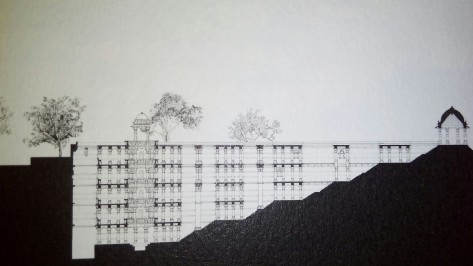
Within a fenced off area stood a domed canopy that looked like a tomb. A group of boys were playing there, their bicycles leaning against an old wall nearby. This place was so devoid of tourists, unlike Adalaj, that these boys seemed very privileged to have us and all of them followed us around as we explored the stepwell.

The dome was actually the umbrella to the pillared entrance pavilion from where the stairs lead you into the dark sombre depths of the five-storied well.

There were two inscriptions, enclosed in shallow niches of shrines with minarets, one on each side-wall, the left in Sanskrit (but in an informal handwriting type script) and the right in Arabic or Persian.
According to Wikipedia:
The Arabic writing reads:[1] This holy and wholesome water; the splendid travellers’ rest-house enclosed on four sides by carved and painted walls, and a grove of fruit trees with their fruit, a well, and a pool of water for the use of man and heist, were built in the reign of the Sultan of the Sultans of the age, established by the grace of God and of the faith, Abul Fath Mahmud Shah, son of Muhammad Shah, son of Ahmed Shah, son of Muhammad Shah, son of Muzaffar Shah the Sultan, may God keep his kingdom. Dated the metropolis of the kingdom the 2nd of Jamadi-ul-awwal in the 26th year of the reign.
A Sanskrit inscription says that the step-well was built in 1500 AD. It was during the reign of Mahmud Shah that Bai Harir Sultani, locally known as Dhai Harir, built the step-well. The name later corrupted into Dada Hari. It costed 3,29,000 Mahmudis (₹ 3 lakh) at that time. The ornate step-well has spiral staircases pieced into the sidewall of the well shaft and descending to the different platform levels.[1][2]
The walls themselves were dark pink with darker markings on them, in a way much darker and serious looking than the orange-yellow-pink walls at Adalaj. The overall look was also much less ornate and definitely sober. However, there were carvings of both Hindu Gods and Islamic motifs, of peafowls kissing/beak fighting, elephants in cavalry and the customary Pot of Ambrosia (Amritkalash) and the Tree of Life (Kalp-vriksha).
Like the inscriptions, these low relief sculptures were also niched within high relief minarets with geometrical carvings. The prominent sculpture that ran along the walls were of a line of large lotuses (Hindu), accentuated with a narrower line of floral vines (Islamic) below.
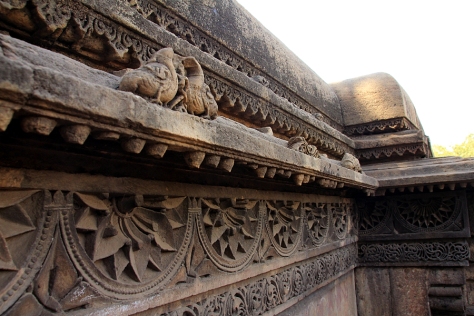
From the second level (the ground level being the first), the stairs led to the third and so on until the fifth. Seen from the landing, the pillars and beams above looked impressive, though devoid of the heavy ornateness as compared to Adalaj.
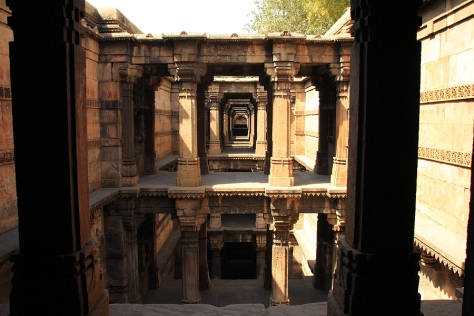
But before we continued our descent, it was fascinating to see how at each landing, the floor of one level (ceiling of the one below) has been cut away leaving only a ledge along the walls, to allow light to the next level.

If you had a brave heart you could walk along these ledges to reach the platform on the other side. We did that, and from here we could see the well shaft, at a distance, with the customary seat that had the backrest towards the shaft.
And then across one more ledge and one more platform and we were on the balcony that surrounded the octagonal Kund well pavilion. The well (Kund) below was, however, a square one. Filled up with silt till the brim, it looked like a courtyard instead.
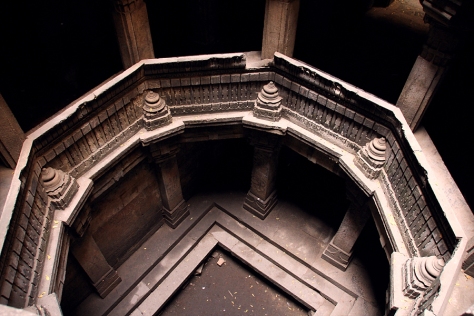
These octagonal balconies (galleries) were at each level, both above and below us. From above, we heard people’s voices and saw a group of foreign tourists with probably a local guide. The boys who were constantly on our heels immediately left us to join them; thank God!
The sculpture on the outer walls of the parapets (low walls railing the galleries) were mind blowing. Repeated rectangular patterns with elaborate geometric cut-ins and cut-outs, punctuated at eight places (corresponding to the eight pillars) by little domed shrines.
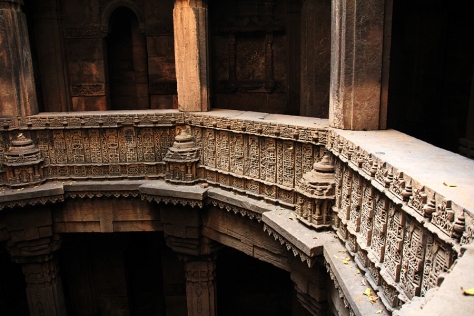
Each of these little shrines had their own carved pillars bounding an Amrit Kalash complete with miniature dragon arches (Ref: Full size dragon/naga arches in Adalaj).
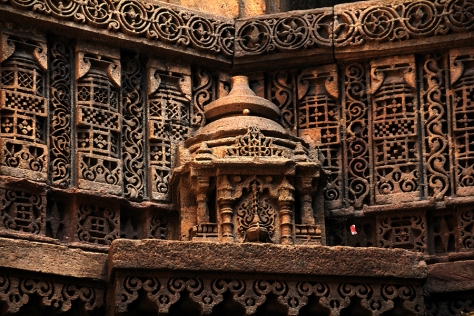
Between the two pillars opposite to us, we could see a window cut in the wall that revealed the well shaft. The wall of the shaft directly opposite to the window held yet another Kalp-vriksha enclosed in a shallow-cut shrine. A line of rock-cut birds emerged from each side of the shrine and probably continued along the circular wall.

We went ahead for a look into the well shaft.
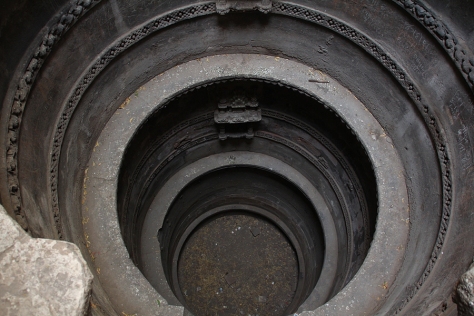
Looking behind, the stairs through which we have descended looked surreal in a strange orange midday light, contrasting starkly against the dark recesses.
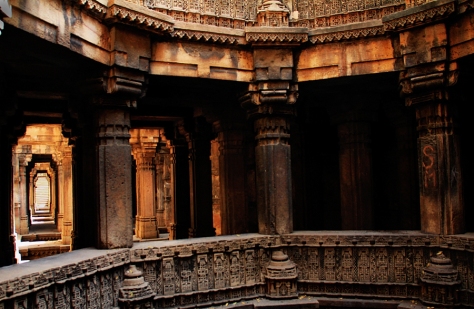
From the gallery, a pair of narrow spiral staircases went up to the ground level and down to the lowest level.
I entered into one of the spiral stairwells and was greeted by a flock of disturbed bats flying out through the opening I got in. A few bats still hung on (literally) but I could not get proper photographs due to poor light. I went down the entire flight till the lowest level. Looking up from the Octagonal Kund was a delightful experience. I always find myself enjoying looking up well shafts and deep recesses of Kunds, looking at the world I reside in with a different view. Deep within the ground the spaces are so fantastically semi-dark, cool and silent, and from the world above sounds of traffic, of humans shouting and pigeons cooing all appear to be mixed up in a faint din that seems almost unreal. Inside the earth, it smells differently too, of age old baths, fragrances of queens and kings, incenses, faint aroma of lichens growing on the stone walls, overpowered sometimes with the strong stench of bat guano.
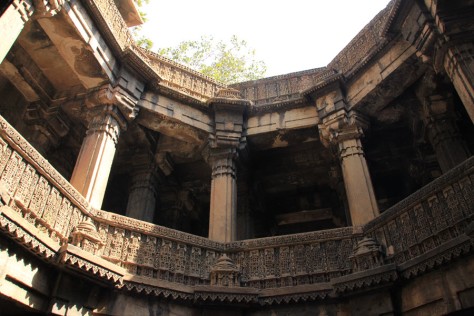
I heard Amrit calling me and climbed back the spiral stairs, promising myself to bring a torch next time to see and photograph the bats. I stopped at each level, trying to photograph the various evolving forms of the Kalp-vriksha motifs and then appeared on the ground level to be greeted by two small domes or cupolas.
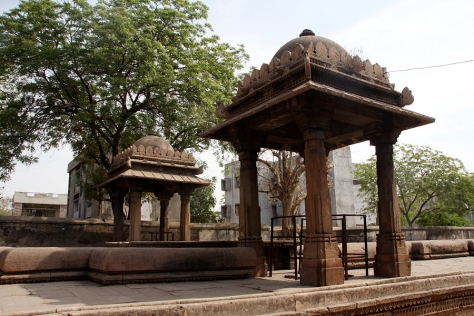
The structure that drew water from the well shaft (probably) a housing for the pulley systems was broken and big chunks of sculpted stone lay here and there. The channel to carry water for cattle was also half broken.
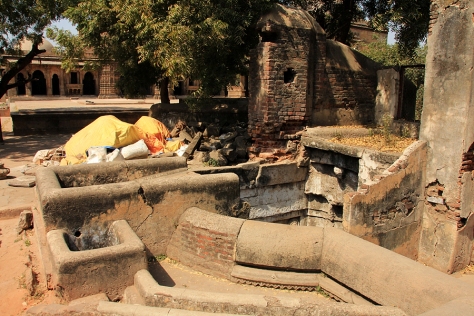
We left the well and went ahead towards what seemed a beautiful mosque located within the same compound.
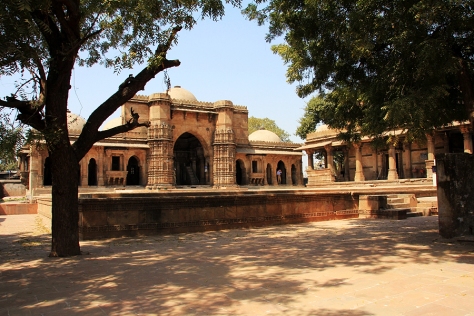
The mosque had beautifully carved pillars and walls, a large dome flanked by two smaller ones at a lower level and inside there were vaulted ceiling corresponding to the domes. The striking feature, however, was the presence of the two Solanki style balconies.
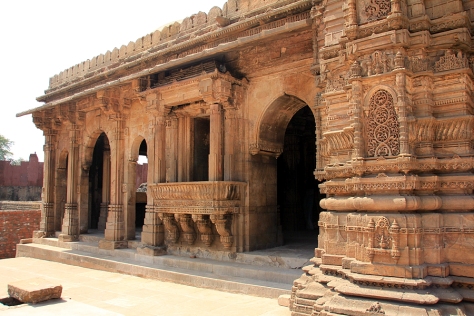
The caretaker of the mosque, Mr. Mahmud, a white-bearded old man, showed us around enthusiastically.
There was a narrow turret that led to the mosque’s roof and Mahmud gestured us to venture up. Climbing up these age old stairs, I felt how before the loudspeakers came into use, the Muazzin would climb these flights five times a day and cry out the prayer call. On the roof, I could touch the domes and it was the first time I was on the roof of a mosque, so it felt really wonderful.
After visiting the mosque we went into another similarly fashioned building, but less sculpted.
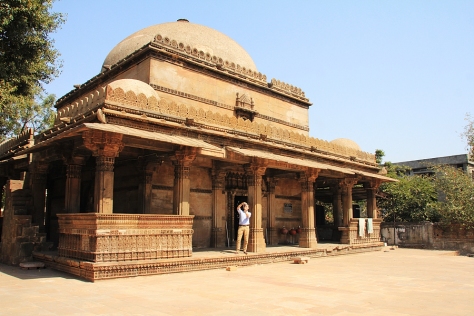
This was the maqbara or the tomb of the queens and also housed the grave of Bai Harir, the lady who was the guard of the royal harem.

It was Bai Harir who built the entire complex of mosque, maqbara and stepwell. Some texts refer to her as Dhai Harir (Dhai = Midwife). And the original name of the stepwell was Bai Harir ni Vav (Bai Harir’s stepwell) which later got distorted into Dada Harir ni Vav (Dada = Male deity). But it was not a Dada, but a lady who thought to provide water to the thirsty humans, animals and spirits in the drought stricken region.
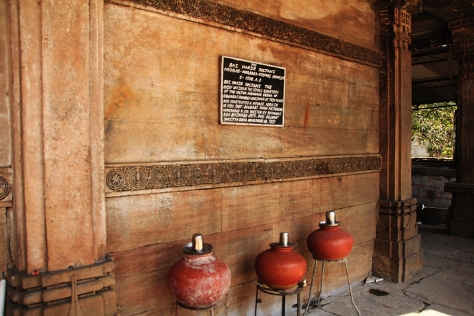
P.S: As my interest in stepwells surged, I ordered the book “Steps to Water: The Ancient Stepwells of India by Morna Livingston. On page 31 of her book Morna writes, An inscription in the early sixteenth-century Dada Harir Stepwell praises the Mother Goddess Devi, who exists “in the form of wells”36 and as pure water, is “every drop a Goddess.”37 (36 – Inscription on Dada Harir, Jain Neubauer, Stepwells of Gujarat, appendix 2. 37 – Eck, Banaras, 61)
And now I have one more reason to revisit, other than the bats.




































 A camel named Shahrukh Khan
A camel named Shahrukh Khan














































